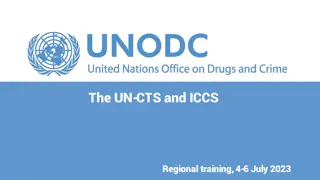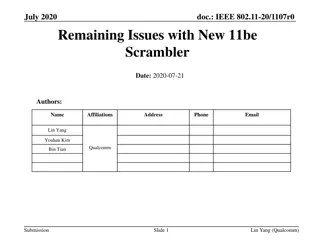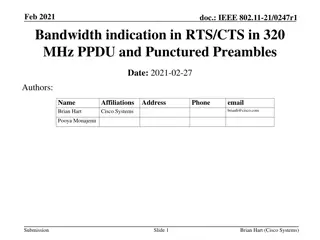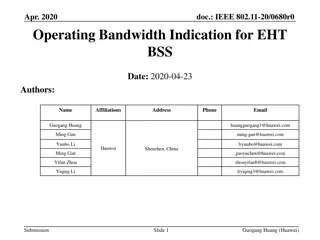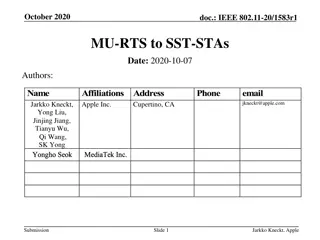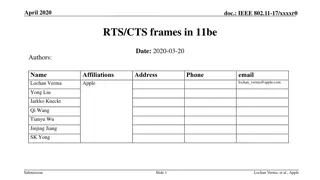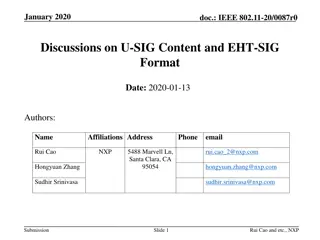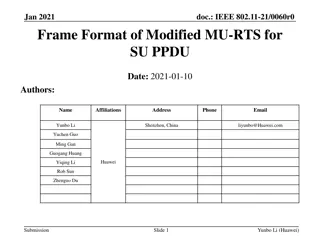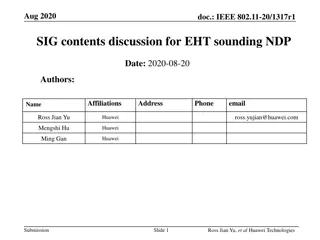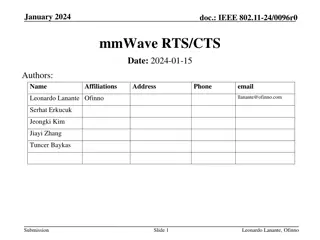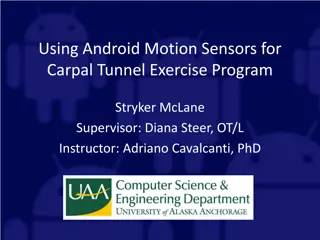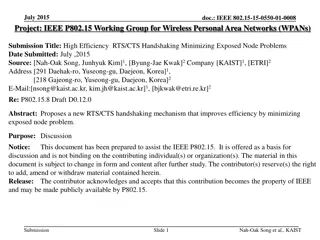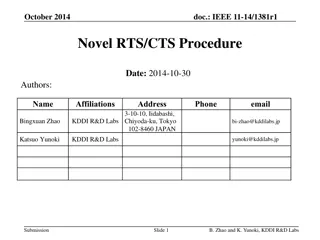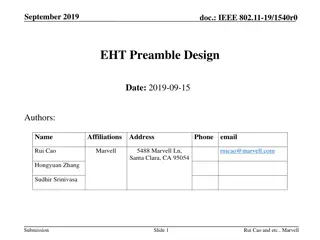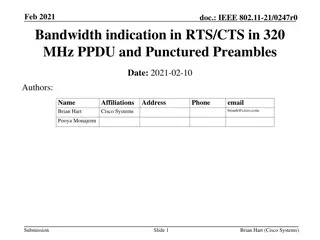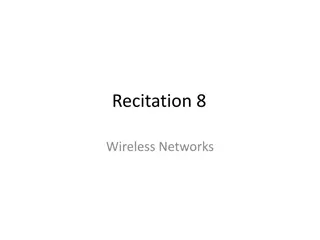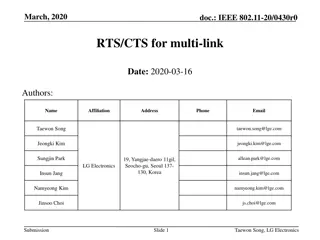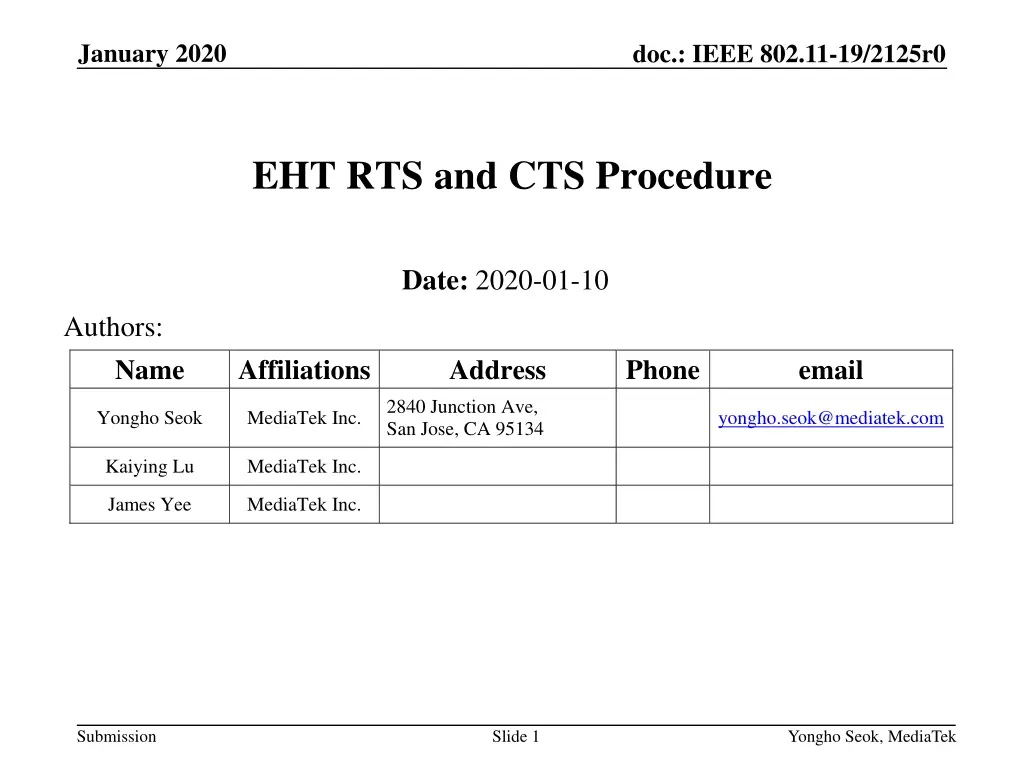
IEEE 802.11-19/2125r0 EHT RTS and CTS Procedure Details
"Explore the detailed IEEE 802.11-19/2125r0 document outlining the EHT RTS and CTS procedure for supporting various bandwidths and preamble puncturing mechanisms in MAC. Learn about proposed frames and transmission specifications for efficient communication."
Download Presentation

Please find below an Image/Link to download the presentation.
The content on the website is provided AS IS for your information and personal use only. It may not be sold, licensed, or shared on other websites without obtaining consent from the author. If you encounter any issues during the download, it is possible that the publisher has removed the file from their server.
You are allowed to download the files provided on this website for personal or commercial use, subject to the condition that they are used lawfully. All files are the property of their respective owners.
The content on the website is provided AS IS for your information and personal use only. It may not be sold, licensed, or shared on other websites without obtaining consent from the author.
E N D
Presentation Transcript
January 2020 doc.: IEEE 802.11-19/2125r0 EHT RTS and CTS Procedure Date: 2020-01-10 Authors: Name Affiliations Address Phone email 2840 Junction Ave, San Jose, CA 95134 Yongho Seok MediaTek Inc. yongho.seok@mediatek.com Kaiying Lu MediaTek Inc. James Yee MediaTek Inc. Submission Slide 1 Yongho Seok, MediaTek
January 2020 doc.: IEEE 802.11-19/2125r0 EHT PHY Support in MAC Agreed EHT PHY features [1] 802.11be supports 320 MHz and 160+160 MHz PPDU. 802.11be needs to support 320 MHz and 160+160 MHz bandwidth indication in the RTS and CTS bandwidth signaling procedure. 802.11be supports 240 MHz and 160+80 MHz transmission. Whether 240/160+80 MHz is formed by 80 MHz channel puncturing of 320/160+160 MHz is TBD. 802.11be needs to support 240 MHz and 160+80 MHz bandwidth indication in the RTS and CTS bandwidth signaling procedure. Submission Slide 2 Yongho Seok, MediaTek
January 2020 doc.: IEEE 802.11-19/2125r0 EHT PHY Support in MAC Agreed EHT PHY features [1] The 802.11be amendment shall support a preamble puncture mechanism for an EHT PPDU transmitted to multiple STAs. 802.11be needs to define the MU-RTS and CTS frames sent in a non- HT duplicate PPDU with preamble puncturing. The 802.11be amendment shall support a preamble puncture mechanism for an EHT PPDU transmitted to a single STA. 802.11be needs to define the RTS and CTS frames sent in a non-HT duplicate PPDU with preamble puncturing. Submission Slide 3 Yongho Seok, MediaTek
January 2020 doc.: IEEE 802.11-19/2125r0 EHT PHY Support in MAC In order to support 240/160+80/320/160+160 MHz bandwidth and the preamble puncture mechanism, a new EHT RTS and CTS frames are proposed. The EHT RTS and CTS frames can be a new Control frame. Because only Subtype 1 and 15 in Control Type are only available, another extension frame that is similar to the Control Frame Extension of 802.11ad/ay can be defined. Submission Slide 4 Yongho Seok, MediaTek
January 2020 doc.: IEEE 802.11-19/2125r0 EHT RTS and CTS Procedure A TXOP holder may transmit to a TXOP responder an EHT RTS frame in a non-HT duplicate PPDU with the following TXVECTOR parameters: CH_BANDWIDTH: CBW40, CBW80, CBW160, CBW80+80, CBW240, CBW160+80, CBW320, CBW160+160. INACTIVE_SUBCHANNELS: Indicates the 20 MHz subchannels that are punctured, if present. Submission Slide 5 Yongho Seok, MediaTek
January 2020 doc.: IEEE 802.11-19/2125r0 EHT RTS and CTS Procedure The TXOP holder shall not transmit the EHT RTS frames on 20 MHz subchannels on which CCAs are busy. The TXOP holder indicates in the Disallowed Subchannel Bitmap field the 20 MHz subchannels on which the EHT RTS frames are not sent. For example, bit field corresponding to 20 MHz subchannel on which the EHT RTS frame is not sent is set to 1. Otherwise, it is set to 0. The TXOP responder is disallowed to transmit the EHT CTS response on the 20 MHz subchannels indicated in the Disallowed Subchannel Bitmap field in the EHT RTS frame. Frame Control 2 octets Duration 2 octets RA TA Disallowed Subchannel Bitmap 2 octets FCS 4 octets 6 octets 6 octets <EHT RTS frame format> Submission Slide 6 Yongho Seok, MediaTek
January 2020 doc.: IEEE 802.11-19/2125r0 EHT RTS and CTS Procedure The TXOP responder transmits to the TXOP holder an EHT CTS frame in a non-HT duplicate PPDU with the following TXVECTOR parameters: CH_BANDWIDTH: CBW40, CBW80, CBW160, CBW80+80, CBW240, CBW160+80, CBW320, CBW160+160. INACTIVE_SUBCHANNELS: Indicates the 20 MHz subchannels that are punctured, if present. The TXOP responder can transmit the EHT CTS frame on only 20 MHz subchannels in which the TXOP holders sent the EHT RTS frames. Submission Slide 7 Yongho Seok, MediaTek
January 2020 doc.: IEEE 802.11-19/2125r0 EHT RTS and CTS Procedure The TXOP responder shall not transmit the EHT CTS frames on 20 MHz subchannels of which CCAs are busy. The TXOP responder indicates in the Disallowed Subchannel Bitmap field the 20 MHz subchannels on which the EHT CTS frames are not sent. For example, bit field corresponding to 20 MHz subchannel on which the EHT CTS frame is not sent is set to 1. Otherwise, it is set to 0. The TXOP holder is disallowed to transmit frames on the 20 MHz subchannels indicated in the Disallowed Subchannel Bitmap field in the EHT CTS frame. Frame Control 2 octets Duration 2 octets RA Disallowed Subchannel Bitmap 2 octets FCS 4 octets 6 octets <EHT CTS frame format> Submission Slide 8 Yongho Seok, MediaTek
January 2020 doc.: IEEE 802.11-19/2125r0 EHT RTS and CTS Procedure For example, the TXOP holder solicits the EHT CTS response on the primary 80 MHz and secondary 80 MHz channel. But, since the TXOP holder indicates that the upper 20 MHz channel of the secondary 40 MHz channel is the disallowed subchannel, the TXOP responder replies with the EHT CTS frame on idle channels excluding the corresponding disallowed subchannel. PIFS EHT RTS At the TXOP responder, CCA is busy. PIFS PIFS PIFS EHT RTS Secondary 80MHz ACK EHT RTS EHT CTS Preamble punctured SU PPDU ACK EHT CTS EHT RTS At the TXOP holder, CCA is busy. EHT CTS PIFS PIFS EHT RTS ACK Primary 80 MHz Preamble punctured SU PPDU ACK EHT RTS EHT CTS SIFS SIFS SIFS ACK EHT RTS EHT CTS Submission Slide 9 Yongho Seok, MediaTek
January 2020 doc.: IEEE 802.11-19/2125r0 EHT MU-RTS and CTS Procedure An AP that is a TXOP holder may transmit to one or more non-AP STAs an EHT MU-RTS Trigger frame in a non-HT duplicate PPDU with the following TXVECTOR parameters: CH_BANDWIDTH: CBW40, CBW80, CBW160, CBW80+80, CBW240, CBW160+80, CBW320, CBW160+160. INACTIVE_SUBCHANNELS: Indicates the 20 MHz subchannels that are punctured, if present. Submission Slide 10 Yongho Seok, MediaTek
January 2020 doc.: IEEE 802.11-19/2125r0 EHT MU-RTS and CTS Procedure The AP shall not transmit the EHT MU-RTS frames on 20 MHz subchannels of which CCAs are busy. The EHT MU-RTS Trigger frame includes the Disallowed Subchannel Bitmap subfield in the User Info field whose the AID12 subfield is set to 2047. The AP indicates in the Disallowed Subchannel Bitmap subfield the 20 MHz subchannels on which the EHT MU-RTS frames are not sent. For example, bit field corresponding to 20 MHz subchannel on which the EHT MU-RTS frame is not sent is set to 1. Otherwise, it is set to 0. The non-AP STA is disallowed to transmit the CTS response on the 20 MHz subchannels indicated in the Disallowed Subchannel Bitmap field in the EHT MU-RTS frame. Submission Slide 11 Yongho Seok, MediaTek
January 2020 doc.: IEEE 802.11-19/2125r0 EHT MU-RTS and CTS Procedure The non-AP STA transmits to the AP a CTS frame in a non- HT duplicate PPDU with the following TXVECTOR parameters: CH_BANDWIDTH: CBW40, CBW80, CBW160, CBW80+80, CBW240, CBW160+80, CBW320, CBW160+160. The RU Allocation subfield in the User Info field addressed to the non-AP STA determines CH_BANDWIDTH parameter. INACTIVE_SUBCHANNELS: Indicates the 20 MHz subchannels that are punctured, if present. The non-AP can transmit the CTS frame on only 20 MHz subchannels in which the AP sent the EHT MU-RTS frames, subject to other rules 26.2.6 (MU-RTS Trigger/CTS frame exchange procedure). Submission Slide 12 Yongho Seok, MediaTek
January 2020 doc.: IEEE 802.11-19/2125r0 EHT MU-RTS and CTS Procedure For example, the AP solicits the CTS response on the primary 80 MHz and secondary 80 MHz channel. But, since the AP indicates that the upper 20 MHz channel of the secondary 40 MHz channel is the disallowed subchannel, the STA responds with the CTS frame on idle channels excluding the corresponding disallowed subchannel. PIFS TB PPDU CTS MU-RTS PIFS PIFS PIFS TB PPDU MU-RTS CTS Preamble punctured MU PPDU Secondary 80MHz TB PPDU MU-RTS CTS TB PPDU CTS MU-RTS At the TXOP holder, CCA is busy. CTS PIFS PIFS TB PPDU MU-RTS Primary 80 MHz Preamble punctured MU PPDU TB PPDU MU-RTS CTS SIFS SIFS SIFS TB PPDU MU-RTS CTS Submission Slide 13 Yongho Seok, MediaTek
January 2020 doc.: IEEE 802.11-19/2125r0 Conclusion 802.11be 240/160+80/320/160+160 MHz bandwidth through the preamble puncture mechanism. Because the chance that continuous channels of 240/320 MHz are idle is very low. This submission proposes the RTS and CTS support for the preamble puncture mechanism (including a support of new bandwidth modes). Additional information to help other EHT features (e.g., the multi- link operation) can be exchanged through the HE RTS and CTS procedure. Other control frames (e.g., BlockAckReq and BlockAck, etc.) that can have the bandwidth signaling TA also need similar updates. can efficiently utilize more wider Submission Slide 14 Yongho Seok, MediaTek
January 2020 doc.: IEEE 802.11-19/2125r0 References [1] https://mentor.ieee.org/802.11/dcn/19/11-19-1262-05- 00be-specification-framework-for-tgbe.docx Submission Slide 15 Yongho Seok, MediaTek
January 2020 doc.: IEEE 802.11-19/2125r0 Straw Poll 1 Do you support to define the (MU-)RTS and CTS procedure for 240/160+80/320/160+160 bandwidth and the preamble puncture mechanism? MHz Submission Slide 16 Yongho Seok, MediaTek

